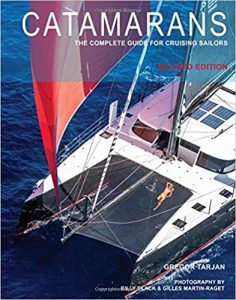5 Star – Truly Superb Structured Overview, Most Ably Illustrated with Photos and Charts, Essential Pre-Reading Before Renting or Buying
Review by Robert David Steele
I have read this book twice and made note of a number of critical considerations to keep firmly in mind if chartering or buying.
This is a large size book (11″ x 9″) and superbly laid out. The paper while glossy lends itself to pen annotation and I have the book heavily annotated.
Having sailed a couple of catamarans and been completely fed up with their apathetic ability to tack with the agility of a monohull, and the very annoying use of spring lines to hold the permanent “bag” where the sail is stored (which means that the battens catch on the spring lines unless you are dead into the wind and have two people to raise the main), this book restored my general interest.
Being a D (Offshore) Skipper from the USNA Offshore Sailing Program I have ample experience heeled over and being uncomfortable as well as dead tired and soaking wet. Note: I cannot say enough good things about the USNA program — I treasure my binder of powerpoint briefing that are a phenomenal supplement to the standard references such as Chapman's Piloting and Seamanship; The Annapolis Book of Seamanship; and less well known, Boatowner's Mechanical and Electrical Manual.
The absolute best things about catamarans are these:
01 You will never be tired from heeling over or being soaking wet — the boat rides within 10 degrees most of the time (indeed you are at risk if it goes further because the wind then gets under the boat to take it toward the 90 degree flip point) and there is ample space to the point that four couples could be on deck or down below and feel that they have privacy.
02 The main cabin has 360 degree views of the outside, unlike a monohull where you are living in a bathtub and have to stick your head up to see anything.
03 Faster than monohulls even with difficulty pointing up, and with a shallower draft, much greater versatility in interesting waters (e.g. reefs).
04 Cannot sink — even badly holed — and highly unlikely to flip if you do not lose your mind and fail to pay attention. The greatest risk is the combination of skipper's getting complacent and not reefing in time, and a very strong micro-burst flipping the boat.
There is only one improvement I can think of for this book: an appendix covering the obvious needed upgrades and the cost-benefit tradeoffs:
01 Mast furling mainsail with the new standing Fat Furl battens being pioneered by Hallberg-Rassey (their 64 is the boat to buy if you insist on being heeled over all the time).
02 Electronic telltales as well as the warning alarm used by single-handed multihull racers, and a means of radically easing the main and jib from inside the cabin.
03 Cruise ship class satellite communications for high-speed Internet access enabling high speed video conferencing and data exchanges from anywhere.
04 Water maker and solar/wind power enhancements that allow substantial reduction of the weight of carried water and fuel.
05 Surface radar for both pirates and floating hazards (I am absolutely certain I am going to meet a floating container at sea).
I am persuaded by Eric Smith of Fountaine-Pagot that daggerboards are not worth the loss of space and increase of risk. At this time the FP Alegria 67 is my choice for best in class, with the Lagoon 50 in second place for those who don't want the upgrades including the small pool for grand-children and the hatches from main cabin and master suite to the foredeck, both important to me.
I personally have no interest in sharing or financing a boat, but I have been very impressed by how FP makes it possible for individuals to create a business around the boat with tax and revenue advantages that make it not just affordable, but a net positive. Their “Own for Less” program appears to be the best taught and best managed, with the caveat that you are at the mercy of the charter service you link up with, and tied to the location where you agree to base the boat.
See Also:
Sailing (Offshore) Book Reviews by Robert David Steele




